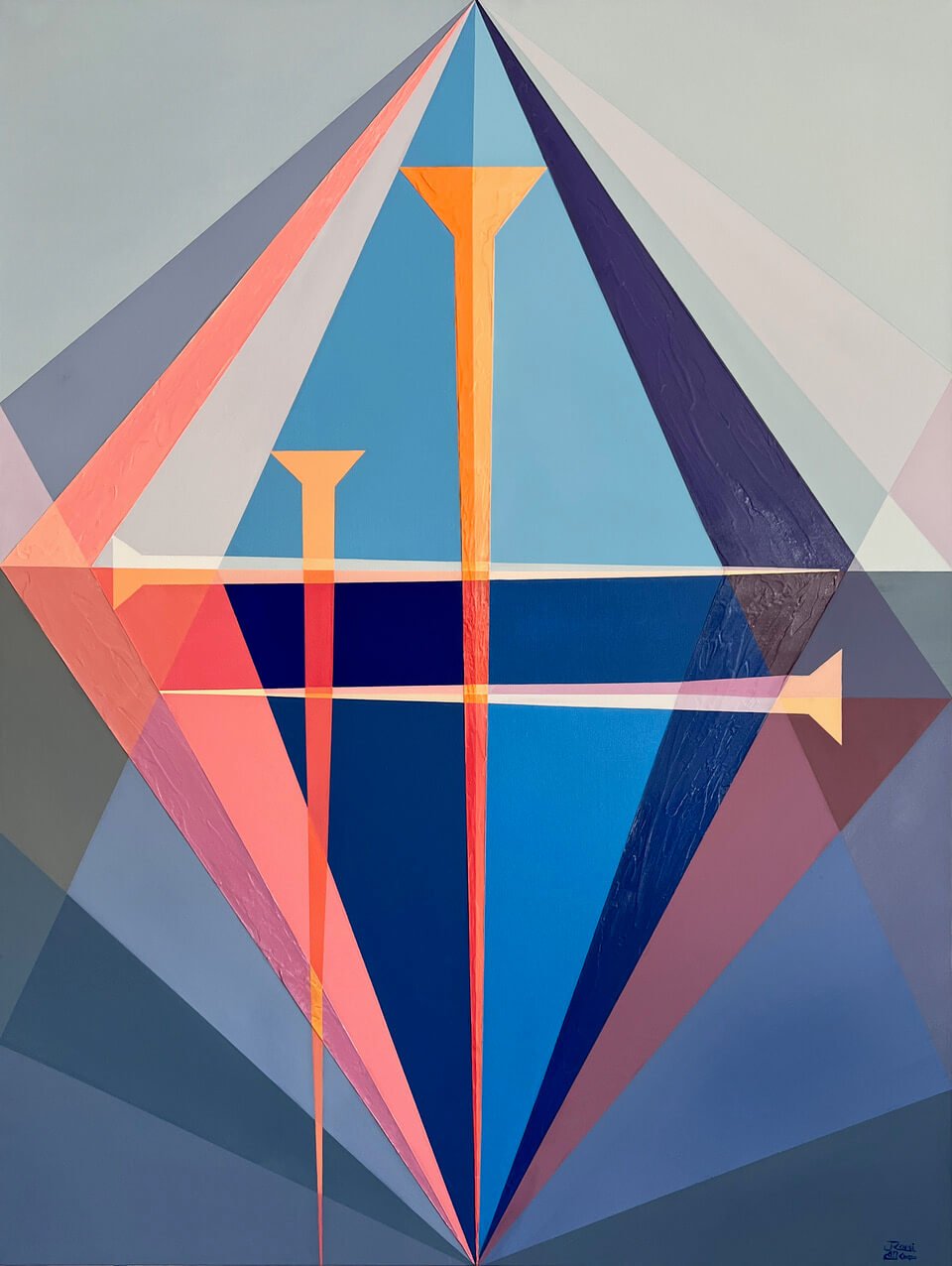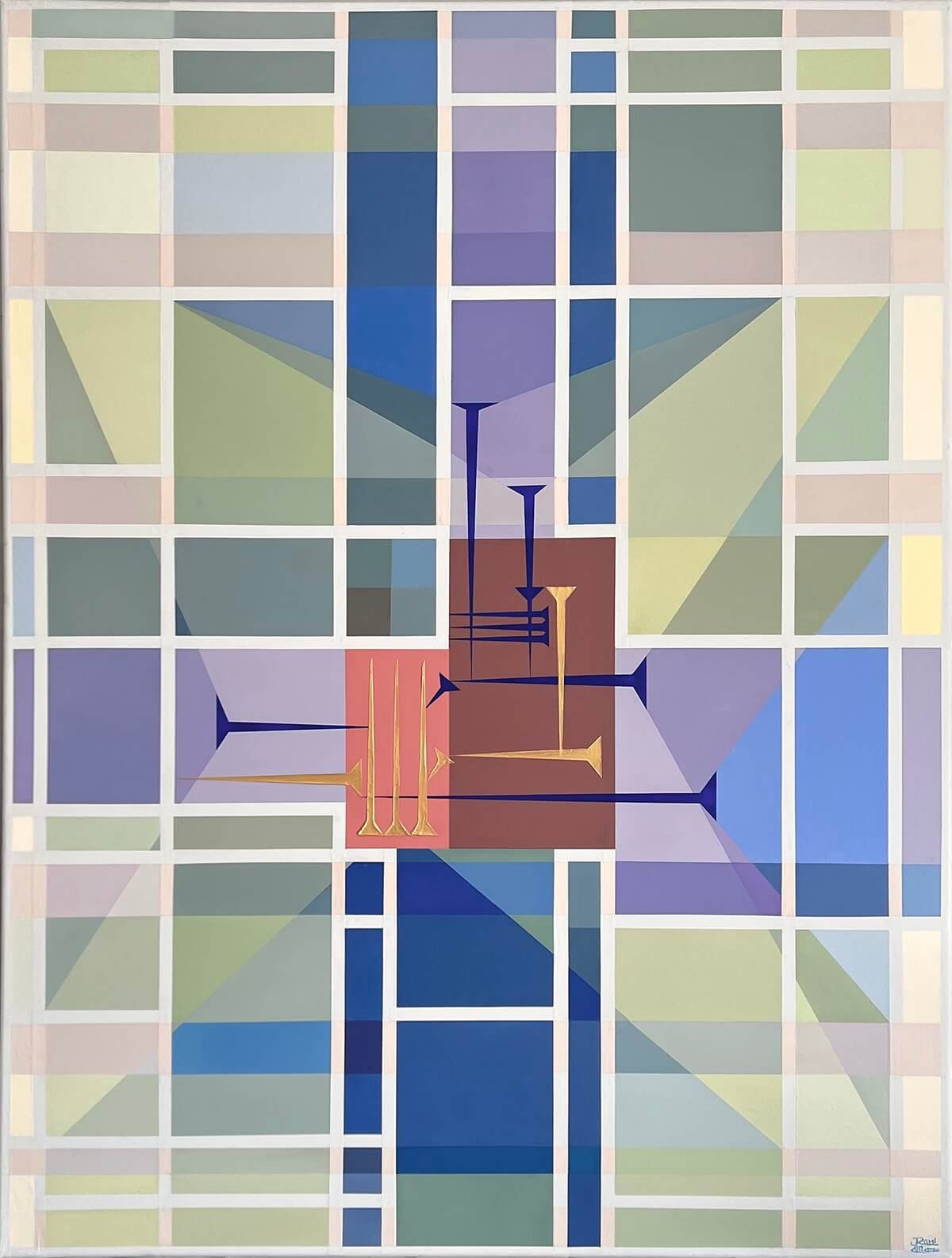John Romi
Contemporary American-Swedish artist John Romi is the founder of Cuneiformism, a unique style he has been refining since 2004. Initially creating figurative canvases, Romi has since transitioned to abstract imagery, incorporating calligraphy and logo-syllabic script into his work. After completing his Master of Science in Engineering, Computer Science, Graphic Arts, and Multimedia at the Royal Institute of Technology in Sweden, Romi began experimenting with the use of cuneiform in his art.
Romi has studied the ancient Mesopotamian script of cuneiform extensively, working alongside some of the foremost scholars in the field. He uses accurate definitions to spell out words and concepts across his canvases. Romi layers the wedge-shaped cuneiform characters against a backdrop of pure, bold hues, hoping that the beauty and peace of his paintings will provide an escape from critical conflict and offer a path toward healing.
Romi has a distinctive way of grouping contrasting organic shapes and reinforcing the focal point through various textures and the use of a palette knife. This approach gives his paintings a vibrant depth and dimension of color. Beyond focusing on texture, color, and geometric composition, Romi places significant emphasis on how much energy and attraction his canvases generate.
Romi believes in the positive effects of his Cuneiformism artworks. Each piece is carefully composed to convey a unified theme, allowing viewers to create their own narrative and perception as they engage with the work.
Artist Statement
My art acts as a positive foundation for those experiencing mental tension, whether directly or indirectly. Beyond the beauty of art, peace through art allows viewers to temporarily escape critical conflict—taking the first step toward healing. It offers balance between the conflicts of the outer world and the stability of the inner world. It can also play a critical role in improving emotions, opinions, and hopes for the future.
I believe in the positive impact of my Cuneiformism canvases. Each artwork is thoughtfully composed to convey a unified theme or perception, while also allowing viewers to create their own interpretations.
www.johnromiart.com
What initially drew you to art?
What initially drew me to art was not only my innate fascination with colors, shapes, and the ability to express emotions, but also my deep desire to make a difference in people's lives through creativity. Art has a unique power to evoke emotions, provoke thoughts, and inspire change. Whether it's a small gesture, like bringing a smile to someone's face with a colorful painting, or a larger impact, such as conveying powerful messages through art activism, I’ve always believed in the transformative potential of artistic expression. Art can offer solace and comfort during difficult times, spark conversations about social issues, or simply bring joy and beauty into the world. Its capacity to touch hearts and minds in profound ways continues to fuel my passion and drives me to explore new avenues of artistic creation.
What elements of your life have ended up becoming a part of your art?
My art is deeply influenced by my experiences and personal interests, including a profound fascination with ancient history, languages, and specifically the world of cuneiform in ancient Mesopotamia. Whether it’s the vibrant hues of nature from my travels, the emotions stirred by personal relationships, or the textures and patterns found in everyday life, these elements are seamlessly woven into my work.
The cuneiform script—its wedge-shaped characters inscribed on clay tablets—holds a special allure for me. The language of ancient Mesopotamia, with its rich literary tradition and complex societal structures, serves as a wellspring of inspiration. From the epic tales of Gilgamesh to the religious texts of the Sumerians and Akkadians, the legacy of cuneiform permeates my work, infusing it with a sense of mystery and antiquity.
As the creator of Cuneiformism, I am deeply influenced by my own fascination with ancient scripts and their cultural significance. This interest shapes my exploration of this ancient form of writing. Additionally, the richness of ancient cultures—their myths, symbols, and stories—often find their way into my art. Whether it's the intricate patterns of Egyptian hieroglyphs, the symbolism of Mayan glyphs, or the majestic ruins of ancient civilizations, these cultural references infuse my work with layers of meaning and depth. My art seeks to bridge the gap between past and present, connecting viewers to timeless narratives and universal truths.
What about your practice do you find the most fulfilling and/or energizing?
The most fulfilling aspect of my practice is the sense of liberation and connection it brings. There is an indescribable energy that comes from the act of creation—a feeling of being in harmony with myself and the universe. The ability to translate thoughts and feelings into tangible artworks is both empowering and rejuvenating.
Tell us about your experience getting to where you are now. What has been the most important thing you’ve learned?
My artistic journey has been a rich tapestry of exploration and evolution. I started with classical realism, honing my skills to capture the world with intricate detail and precision. Then, I ventured into impressionism, where I explored the enchantment of capturing fleeting moments with fluid brushwork and vivid hues. Fauvism followed, revealing the expressive power of color and urging me to push the boundaries of representation. I also embraced figurative art, delving into themes of identity and existence.
However, it was my fascination with ancient history and the enigmatic allure of cuneiform script that sparked a transformative revelation. Drawing inspiration from antiquity, I began incorporating geometric forms and cuneiform motifs into my compositions. This synthesis birthed a new style, merging tradition with modernity. By reinterpreting cuneiform through a contemporary lens, my art transcends temporal confines, inviting viewers to contemplate timeless truths and universal themes.
How has ‘community’ impacted your artistic practice?
Community plays a vital role in my artistic practice. Engaging with fellow artists, collectors, and art enthusiasts not only provides valuable feedback and support but also fosters a sense of belonging and shared purpose. For example, visiting Art Miami this year was eye-opening and helped solidify the direction my art is taking. I enjoy collaborating and exhibiting through various curatorial visions. Online platforms have allowed me to connect with diverse communities that inspire and challenge me to grow as an artist. The exchange of ideas and experiences within these communities enriches my practice and fuels my creative spirit.






















